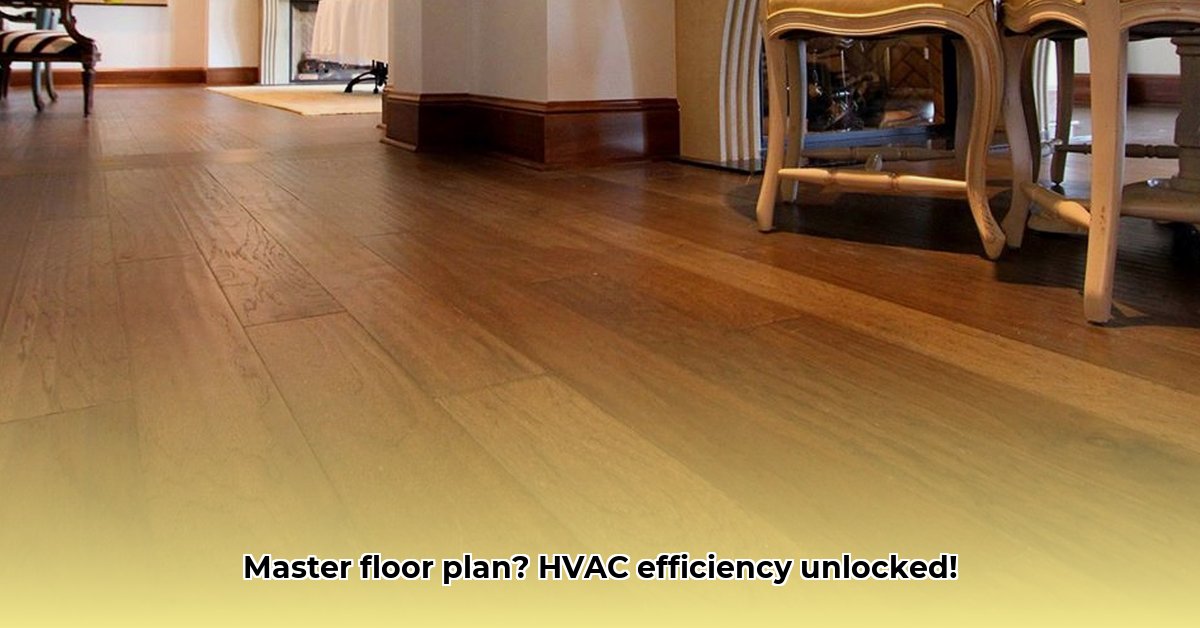Getting the most out of your building’s heating and cooling begins with smart planning. Where you place components – especially the HVAC system – makes a significant difference in energy usage and occupant comfort. This guide will walk you through designing efficient HVAC floor plans, providing expert tips and tricks to make your building design energy-smart and cost-effective. We’ll even cover the latest design trends to help you create an environmentally friendly space. For detailed examples, check out these floor plan examples.
Floor Plan with HVAC Layout: Designing for Energy Efficiency and Air Quality
Designing a building’s heating, ventilation, and air conditioning (HVAC) system is a significant undertaking that directly impacts occupant comfort and a building’s energy consumption. Properly integrating the floor plan with HVAC layout from the outset is key to creating an efficient and comfortable space while optimizing indoor air quality.
Understanding the Basics: How HVAC Interacts with Building Design
Before diving into HVAC design, understand how an HVAC system works within a building’s design. The HVAC system functions as the building’s circulatory system; the ductwork delivers conditioned air—air heated or cooled to a comfortable temperature. A floor plan with a well-planned HVAC layout ensures efficient airflow. Poor planning can lead to uncomfortable drafts, hot and cold spots, and wasted energy, costing you money.
Consider these factors early on:
- Building Orientation: A building’s position relative to the sun impacts heating and cooling needs. South-facing walls receive more sunlight and may require extra shading to prevent overheating.
- Insulation Performance: Good insulation minimizes energy loss. The better the insulation, the less your HVAC system has to work, affecting the size of the HVAC equipment needed and increasing long term energy savings.
- Window Placement Strategies: Large windows provide natural light but also allow heat to escape in winter and enter during summer. Consider this when planning your HVAC system to optimize passive solar design.
- Occupancy Load Calculation: Determine how many people will occupy each room. A crowded office needs more cooling than a storage room. Knowing occupancy patterns helps determine the right heating and cooling capacity for each area.
Creating Your Floor Plan with HVAC Layout: A Step-by-Step Approach
Follow these steps for achieving effective HVAC zoning.
-
The Initial Architectural Sketch: Start with a basic floor plan. Mark high-occupancy areas versus less-occupied ones. Room sizes matter, as larger rooms require more power from your HVAC system.
-
Equipment Selection and Sizing: Select HVAC equipment matching your building’s needs. Consider energy efficiency ratings like the Seasonal Energy Efficiency Ratio (SEER) for air conditioners and the appropriate size. An oversized unit wastes energy; an undersized one will struggle to keep up, causing energy waste.
-
Duct Layout and Design: Ductwork placement influences efficiency. Keep duct runs short and straight to minimize energy loss. Insulated ducts are a great investment, improving energy efficiency. Clearly show the ductwork layout on your floor plan, optimizing airflow dynamics.
-
Vent and Register Placement: These are the air distribution components. Placement is key for even air distribution. Careful planning, considering heat loads and occupancy in each area, is crucial. Correct sizing is also important.
-
Smart Building Automation: Integrate smart thermostats or a building management system (BMS). These systems optimize energy use and improve comfort by allowing customized temperature settings in different areas.
Optimizing Your Design: Details and Long Term Cost Savings
Now for the details that make a difference to building performance.
-
Zoning Your Climate Control: Divide your building into separate climate zones. This allows independent temperature control in each zone, particularly helpful in larger buildings or those with varied occupancy, increasing energy conservation.
-
Airflow and Furniture Placement: Avoid placing furniture that could block air vents or registers. Poor airflow impacts efficiency and comfort, lowering the carbon footprint.
-
Accessibility for Maintenance: Design for easy maintenance access. Clearly label all components to simplify repairs and servicing, ensuring system longevity.
Software and Tools: HVAC Modeling
HVAC design software can provide HVAC modeling capabilities. Many programs offer 3D modeling and airflow simulation to visualize how air will flow and identify potential problems before construction begins. Some also enable collaboration with other design professionals. Popular options include Revit, AutoCAD, and SketchUp with HVAC plugins.
Conclusion: A Well-Planned HVAC System Matters
A well-designed floor plan with HVAC layout sets the stage for energy efficiency and occupant comfort, leading to lower operating costs. By carefully following these steps and using available design tools, you’ll create a building that is both comfortable and cost-effective. The effort put into upfront planning pays off – it’s an investment that benefits everyone involved in sustainable design.
How to Optimize VRF System Design for Energy Efficiency and Cost Effectiveness
VRF (Variable Refrigerant Flow) systems offer energy savings compared to traditional HVAC, but planning is crucial when considering cost effectiveness.
Key Takeaways:
- VRF systems offer energy savings compared to traditional HVAC, but careful planning is crucial.
- Proper system sizing, considering peak loads and diversity factors, is paramount for optimal performance.
- Strategic placement of indoor units impacts both aesthetics and air distribution.
- Regular maintenance and leak detection are essential for long-term efficiency and preventing environmental damage.
- Understanding and complying with local building codes and regulations is crucial.
Understanding Your Building’s Needs
Before optimizing VRF system design for energy efficiency, assess your building’s requirements. What are its thermal loads? What are the occupancy patterns? What are your climate conditions? These factors influence optimal system design. A thermal load calculation identifies heating and cooling needs, forming the basis for accurate sizing and lowering environmental impact.
System Sizing and Selection
Accurate sizing is the cornerstone of efficient VRF operation. Undersized systems struggle to meet peak demands, leading to inefficiency and discomfort. Oversized units cycle on and off frequently, also wasting energy. Consider factors like building orientation, solar heat gain, and insulation levels for precise calculations. Determine which VRF system type is best suited to your needs: air-cooled, water-cooled, or geothermal. Climate and building characteristics dictate the best option for long term energy savings.
Optimizing Indoor Unit Placement
The placement of indoor units impacts air distribution and energy efficiency. Ideally, position units to minimize duct runs and maximize airflow. Think about the relationship between building layout and unit location, and consider factors like furniture placement and occupant comfort. Poor placement can lead to uneven temperature distribution and increased energy usage, impacting building performance.
Leveraging Advanced Controls
Modern VRF systems offer sophisticated control options, enabling temperature regulation in individual zones. These systems can learn occupancy patterns and adjust accordingly. Smart controls can minimize energy consumption by automatically adapting to building usage. Consider investing in advanced controls for energy efficiency gains and effective energy management.
Regular Maintenance and Monitoring
Preventative maintenance is an investment in long-term efficiency and system longevity. Regular inspections, including refrigerant leak detection and filter cleaning, are critical. Monitor energy consumption to quickly identify potential problems. Proactive maintenance prevents small issues from escalating, ensuring optimal performance and system longevity.
Navigating Regulatory Compliance
Compliance with local building codes and energy efficiency standards is crucial. Familiarize yourself with relevant regulations to ensure your project adheres to all requirements, avoiding penalties and ensuring legal compliance with HVAC standards.
Addressing Potential Challenges
VRF systems present challenges. Refrigerant leaks pose a risk, environmentally and financially. Regular leak detection and preventative maintenance are crucial. Another concern is the potential for control system failures. Investing in redundant systems and reliable components mitigates this risk, improving HVAC technologies.
HVAC Design for High-Rise Buildings: A Comprehensive Guide
Designing HVAC for skyscrapers involves energy efficiency, and it presents unique challenges compared to single-story buildings.
Key Takeaways:
- Designing HVAC systems for high-rises presents challenges due to vertical airflow, load balancing, space limitations, and energy efficiency needs.
- Solutions like VRF systems and central water-cooled systems help overcome these challenges.
- Advanced zoning strategies are key to ensuring occupant comfort and reducing energy waste.
- Thorough planning, engineering, and proactive maintenance are essential for successful implementation.
- Compliance with building codes and ASHRAE standards is essential. A professional engineer is needed to sign of on a new building.
- Gray Kitchen Backsplash Ideas: Find Your Perfect Gray Tile - December 11, 2025
- Glass Wall Tiles For Bathroom: A Stylish, Durable Choice - December 10, 2025
- Glass Mosaic Kitchen Backsplash: Add Shimmer and Style - December 9, 2025









